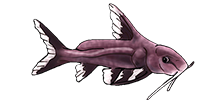Will S. Multipunctatus eat small cichlids?
Will S. Multipunctatus eat small cichlids?
I just lost two giant petricolas (4in and 6in) after they jumped out of my tank (I had covered the holes with hard plastic, but have since reinforced the coverings). It was awful.... They were great fish and didn't bother my juvenile cichlids at all. I'm wondering if three adult S. Multis would be equally amiable toward these fish in my 29g:
3 Alto. compressiceps (~3/4in.)
3 Alto. calvus (~3/4in.)
2 Juli. regani (~3/4in.)
1 common pleco (~3in.)
As I said, I had no trouble with the petricolas in this setup, and it is essentially a grow out tank until my 90g is ready to stock. Thanks in advance.
Matt
3 Alto. compressiceps (~3/4in.)
3 Alto. calvus (~3/4in.)
2 Juli. regani (~3/4in.)
1 common pleco (~3in.)
As I said, I had no trouble with the petricolas in this setup, and it is essentially a grow out tank until my 90g is ready to stock. Thanks in advance.
Matt
-
corybreed
- Expert
- Posts: 919
- Joined: 23 Mar 2004, 23:39
- I've donated: $54.00!
- My catfish: 8
- My cats species list: 74 (i:8, k:0)
- Spotted: 6
- Location 1: Long Island, New York, USA
- Location 2: Long Island
- pturley
- Posts: 833
- Joined: 08 Jul 2003, 23:11
- I've donated: $66.00!
- My articles: 2
- My images: 16
- My cats species list: 1 (i:0, k:0)
- Spotted: 8
- Location 1: Cleveland, Ohio USA
- Yann
- Posts: 3617
- Joined: 30 Dec 2002, 20:56
- I've donated: $20.00!
- My articles: 8
- My images: 276
- My cats species list: 81 (i:0, k:0)
- My BLogs: 2 (i:3, p:90)
- Spotted: 109
- Location 1: Switzerland
- Location 2: Switzerland
- Interests: Catfish mainly form South America, Cichlids, Geckos, Horses WWII airplanes, Orchids
- Dinyar
- Posts: 1286
- Joined: 31 Dec 2002, 00:34
- My articles: 3
- My images: 227
- My catfish: 10
- My cats species list: 3 (i:10, k:0)
- Spotted: 94
- Location 1: New York, NY, USA
- Interests: Mochokidae, Claroteidae, Bagridae, Malepteruridae, Chacidae, Heteropneustidae, Clariidae, Sisoridae, Loricariiadae
No. There are many predatory cichlîds in the Lake, and some predatory catfish, but Synodontis are not among the latter group. Synodontis are fairly easy-going omnivores. Some are a bit boisterous, but no Synodontis species in Lake Tang or elsewhere is an aggressive piscivore.yannfulliquet wrote:Hi!
Aren't Syno the biggest predator group in Lake Tanganyika???
Cheers
Yann
Dinyar
- sidguppy
- Posts: 3827
- Joined: 18 Jan 2004, 12:26
- My articles: 1
- My images: 28
- My aquaria list: 5 (i:0)
- Spotted: 9
- Location 1: Southern Netherlands near Belgium
- Location 2: Noord Brabant, Netherlands
- Interests: African catfishes and oddballs, Madagascar cichlids; stoner doom and heavy rock; old school choppers and riding them, fantasy novels, travelling and diving in the tropics and all things nature.
- Contact:
don't worry about the Syno's.
they WILL eat fry when given the oppertinuty, but only real tiny fry; leftovers from cavedwelling cichlids and only the smallest babies from mouthbreeding cichlids.
Any fish bigger than 1/2-3/4" (>1cm) is perfectly safe.
As soon as fish are truly swimming (no "tadpoles" anymore), They're safe from Synodontis.
Phyllonemus and Lophiobagrus play a whole different ballgame, however!
Despite their moderate/small size as adult (4"or so), they can and will eat fish up to 1/3 of their own size.....
So you don't need a really big cat to get a piscivore catfish from Tanganyika.
they WILL eat fry when given the oppertinuty, but only real tiny fry; leftovers from cavedwelling cichlids and only the smallest babies from mouthbreeding cichlids.
Any fish bigger than 1/2-3/4" (>1cm) is perfectly safe.
As soon as fish are truly swimming (no "tadpoles" anymore), They're safe from Synodontis.
Phyllonemus and Lophiobagrus play a whole different ballgame, however!
Despite their moderate/small size as adult (4"or so), they can and will eat fish up to 1/3 of their own size.....
So you don't need a really big cat to get a piscivore catfish from Tanganyika.
Valar Morghulis




